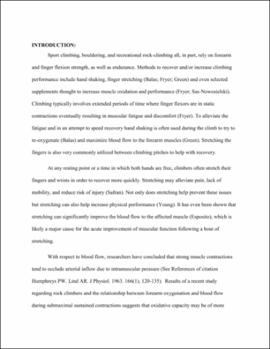| dc.contributor.author | Garcia, Nicholas | |
| dc.date.accessioned | 2022-05-04T13:55:42Z | |
| dc.date.available | 2022-05-04T13:55:42Z | |
| dc.date.issued | 2022-04-19 | |
| dc.identifier | oksd_garcia_HT_2022 | |
| dc.identifier.uri | https://hdl.handle.net/11244/335494 | |
| dc.description.abstract | Introduction: Due to the growing popularity of sports climbing and other grip strength dependent sports, there has been increasing interest in determining the best method for intermittent recovery during extended climbing bouts to help combat forearm and finger flexor fatigue. The two main methods utilized by climbers to do so are 'shaking out' and passive stretching via wrist and finger extension. Presumably, these techniques are utilized to reduce the occluded arterial inflow brought upon by intramuscular pressure, which reduces oxygenation of the active muscles. | |
| dc.description.abstract | Methods: Forty-five college-age males and females participated in this IRB approved study and were randomly assigned to three groups: 'shaking out', stretching, and resting (control) with the arms at the side. Prior to assessing maximal hang time, each participant's grip strength was measured. Subsequently, each participant was asked to hang by the proximal interphalangeal joints of digits 2-5 for maximal time. Following the maximal hang time, the participants performed one of the three protocols for 30s and grip strength was again assessed, and a second maximal hang time was recorded. Data collected during the study was compared using repeating measures ANOVA with an alpha level set at p<0.05. | |
| dc.description.abstract | Results: There were no significant differences among pre- grip strength results between the groups and no significant (p>0.05) differences from pre- to post grip strength assessments for any of the conditions (Table 1). However, the shake and stretch conditions recorded slightly larger post-test grip deficits (-13.3% and -13.1% respectively) than the rest condition (-8.1%). For maximal hang time no pre-hang significant (p>0.05) differences were found among the conditions. However, each condition registered significant (p<0.05) pre- to post-test changes (Table 2) but no significant differences were found between the conditions. | |
| dc.description.abstract | Conclusion: While the rest condition resulted in slightly less grip strength fatigue following maximal hang time, post-hang time was not affected by any of the conditions presented in this research. These results suggest that none of the protocols used in the current study is superior in reducing occlusion and restoring of muscle oxygenation. | |
| dc.format | application/pdf | |
| dc.language | en_US | |
| dc.rights | Copyright is held by the author who has granted the Oklahoma State University Library the non-exclusive right to share this material in its institutional repository. Contact Digital Library Services at lib-dls@okstate.edu or 405-744-9161 for the permission policy on the use, reproduction or distribution of this material. | |
| dc.title | Comparison of selected recovery techniques on grip strength and endurance following a simulated rock-climbing static hang | |
| osu.filename | oksd_garcia_HT_2022.pdf | |
| osu.accesstype | Open Access | |
| dc.type.genre | Honors Thesis | |
| dc.type.material | Text | |
| dc.contributor.director | Jacobson, Bert | |
| dc.contributor.facultyreader | Dawes, Jay | |
| thesis.degree.discipline | Kinesiology, Applied Health and Recreation | |
| thesis.degree.grantor | Oklahoma State University | |
